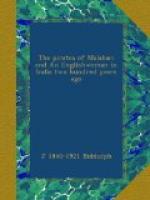[1] Yule’s “Marco Polo.”
[2] The ‘Kempason’ and ‘King Kemshew’ of Downing.
[3] From the Arabic ghorab, ‘a raven.’
[4] Known in the English annals of the time as the
Sow Rajah, and the
South Rajah.
[5] The principal forts were Kennery, Colaba, Severndroog,
Viziadroog or
Gheriah, Jyeghur, Deoghur,
Manikdroog, Futtehghur, Oochitghur; and
Yeswuntdroog.
[6] See page 264.
[7] The name of this pirate is also given as Congdon and Condent.
CHAPTER IV
AN ACTIVE GOVERNOR
Arrival of Mr. Boone as Governor—He builds ships and improves defences of Bombay—Desperate engagement of Morning Star with Sanganians—Alexander Hamilton—Expedition against Vingorla—Its failure—Hamilton made Commodore—Expedition against Carwar—Landing force defeated—Successful skirmish—Desertion of Goa recruits—Reinforcements—Landing force again defeated—The Rajah makes peace—Hamilton resigns Commodoreship—A noseless company—Angria recommences attacks—Abortive expedition against Gheriah—Downing’s account of it—Preparations to attack Kennery.
On the 26th December, 1715, Bombay was en fete. The East Indiamen Stanhope and Queen had arrived from England, bringing the new Governor, Mr. Charles Boone, and three new councillors. His predecessor, Mr. Aislabie, had sailed for England in October. At the landing-place the new-comers were met by the late council and the principal inhabitants and merchants of Bombay. Thirty-one pieces of ordnance greeted them with a salvo, and, as they put foot on shore, three companies of soldiers saluted them with three volleys of small arms.
Boone was a man of very different stamp from his predecessors. The quarrels, intrigues, and self-seeking that had been so disastrous a feature during the tenure of office of Child, Waite, and Gayer were abhorrent to him. He was a zealous servant of the Company, whose interests he did his best to promote with the inadequate means at his disposal. In coming up the coast he had touched at the places where the Company had factories, and by the time of his arrival in Bombay he had fully realized that the pirate question demanded serious treatment.
Bombay was then an open town, only the factory being fortified. Soon after receiving Bombay from the Crown, the Directors had ordered it to be fortified, but had refused to employ skilled officers, because “we know that it is natural to engineers to contrive curiosities that are very expensive.” The only protection to the town was such as was afforded by a number of martello towers along the shore. Nineteen years before Boone’s time the Muscat Arabs had made a descent on Salsette, ravaging, burning, and plundering as they pleased, killing the Portuguese priests and carrying off fourteen hundred captives into slavery. Since then the formidable power of Angria had arisen, but nothing had been done to improve the defences of the settlement. Boone’s first care was to trace out an enclosing wall, the building of which was to be paid for by contributions from the native merchants.




